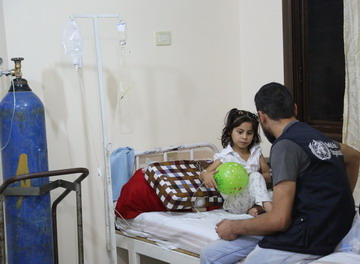 More than 11.3 million Syrians are in need of health assistance, including almost 3 million people living in besieged or hard-to-reach areas.
More than 11.3 million Syrians are in need of health assistance, including almost 3 million people living in besieged or hard-to-reach areas.
WHO delivered 14 million medical treatments to people in need in 2017, including 3 million treatments delivered cross-border. More than two-thirds of besieged areas were reached with health aid in 2017. WHO’s supply tracking system monitors the distribution of medicines, supplies and equipment to health care facilities, and WHO focal points throughout Syria regularly visit health care facilities and mobile clinics to report on health needs and available stocks of priority medicines.
Immunization coverage rates are impacted by the destruction, and 1 in 3 children has missed out on life-saving vaccinations.
WHO and partners supported supplementary immunization activities in 2017, reaching 2.5 million children (ages 0-59 months) with 3 doses of polio vaccine and vaccinating 5 million children (ages 6 months-12 years) against measles in 2017. Almost 2.4 million children were vaccinated through cross-border immunization activities.
More than half of the Syria’s health facilities have been damaged or destroyed, and health workers are among those fleeing the country.
WHO rehabilitated six primary health care centres in four governorates, re-equipped one hospital in Aleppo, and fully rehabilitated the emergency department of Al-Muasat Referral Hospital in Damascus in 2017. To strengthen the capacity of the health work force WHO trained more than 27 000 health workers on a wide range of topics last year.
35% of all Syrians have no access to safe drinking water, putting them at risk of waterborne diseases like diarrheal diseases and typhoid fever.
In 2017, more than 650 unsafe sources of drinking water were tested and treated by WHO and partners, including water storage tanks in camps for internally displaced people in north-east Syria and groundwater wells in Aleppo governorate, providing clean water to almost 200,000 people. WHO also supported the rehabilitation of water supply systems in five hospitals in Aleppo, Damascus and Qamishli.
Unsanitary living conditions in camps for internally displaced people, increasing rates of malnutrition, and low vaccination rates across the country are increasing the risk of disease outbreaks.
To monitor the spread of infectious diseases, 1670 sentinel sites across the country report to WHO’s disease surveillance system. Since the beginning of the crisis, this system has allowed WHO and partners to rapidly detect and respond to hepatitis A, typhoid fever, leishmaniasis, polio and measles across Syria and on the borders of neighbouring countries.
Malnutrition rates are on the rise, decreasing the immunity of children against life-threatening infectious disease.
743 000 were children screened for malnutrition in 586 WHO-supported nutrition surveillance centres in 2017. WHO is also helping to strengthen the national nutrition surveillance system and has supported the establishment of 17 nutrition stabilization centres to treat children with severe acute malnutrition with medical complications.
1 in 30 Syrians is suffering from a severe mental health condition, and at least 1 in 10 is suffering from a mild to moderate mental health condition as a result of prolonged exposure to violence.
WHO is supporting the integration of mental health services into primary health care centres and community centres across the country. More than 400 health care facilities in Syria are now providing mental health and psychosocial support services. In 2017, WHO’s hub in Gaziantep, Turkey rolled out the Mental Health Gap Action Programme in north-west Syria and trained more than 250 Syrian health care workers and mental health professionals.
The total number of people with different types of disabilities is estimated at 2.9 million, including 1.5 million people with war-related injuries. They are at a greater disadvantage in accessing much needed healthcare services.
WHO has procured and distributed supplies to produce 700 artificial limbs to public rehabilitation centres in Damascus and Homs and provided additional 337 artificial limbs through NGOs. To further expand services for rehabilitation, WHO is working with the Ministry of Health to fix and equip two damaged rehabilitation centres — one in Homs and one in Aleppo.
Related link
Seven years of Syria’s health tragedy
News release








